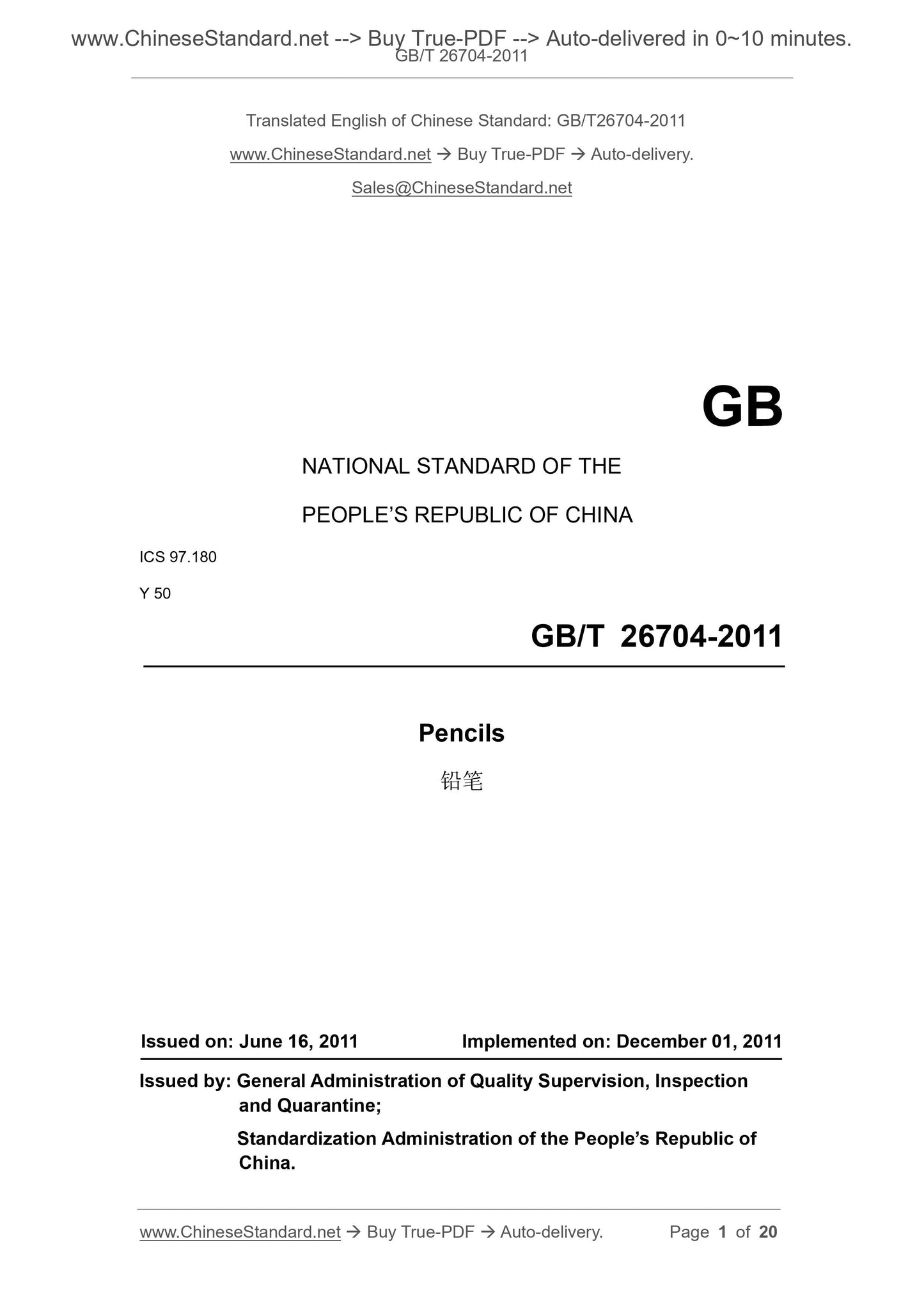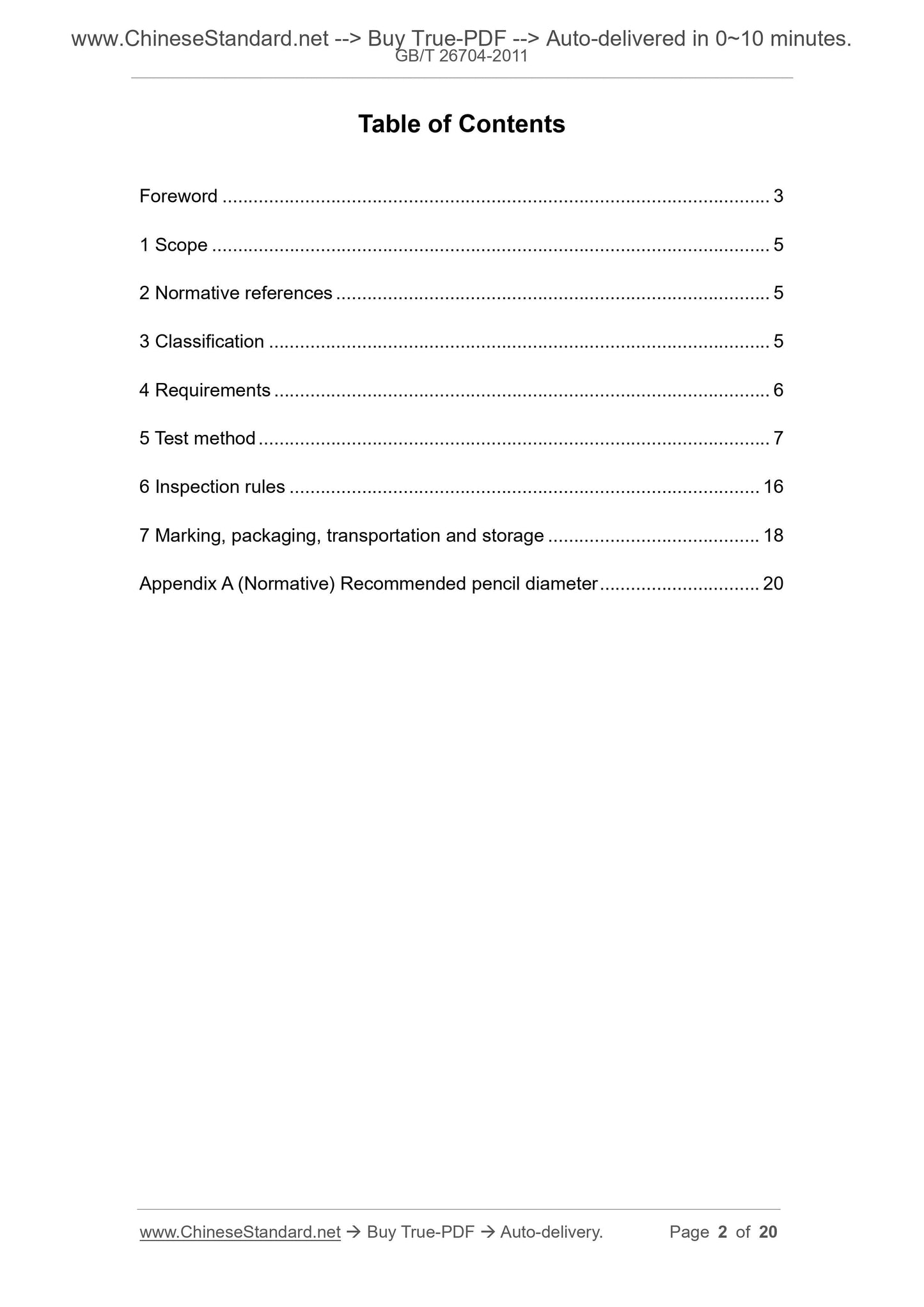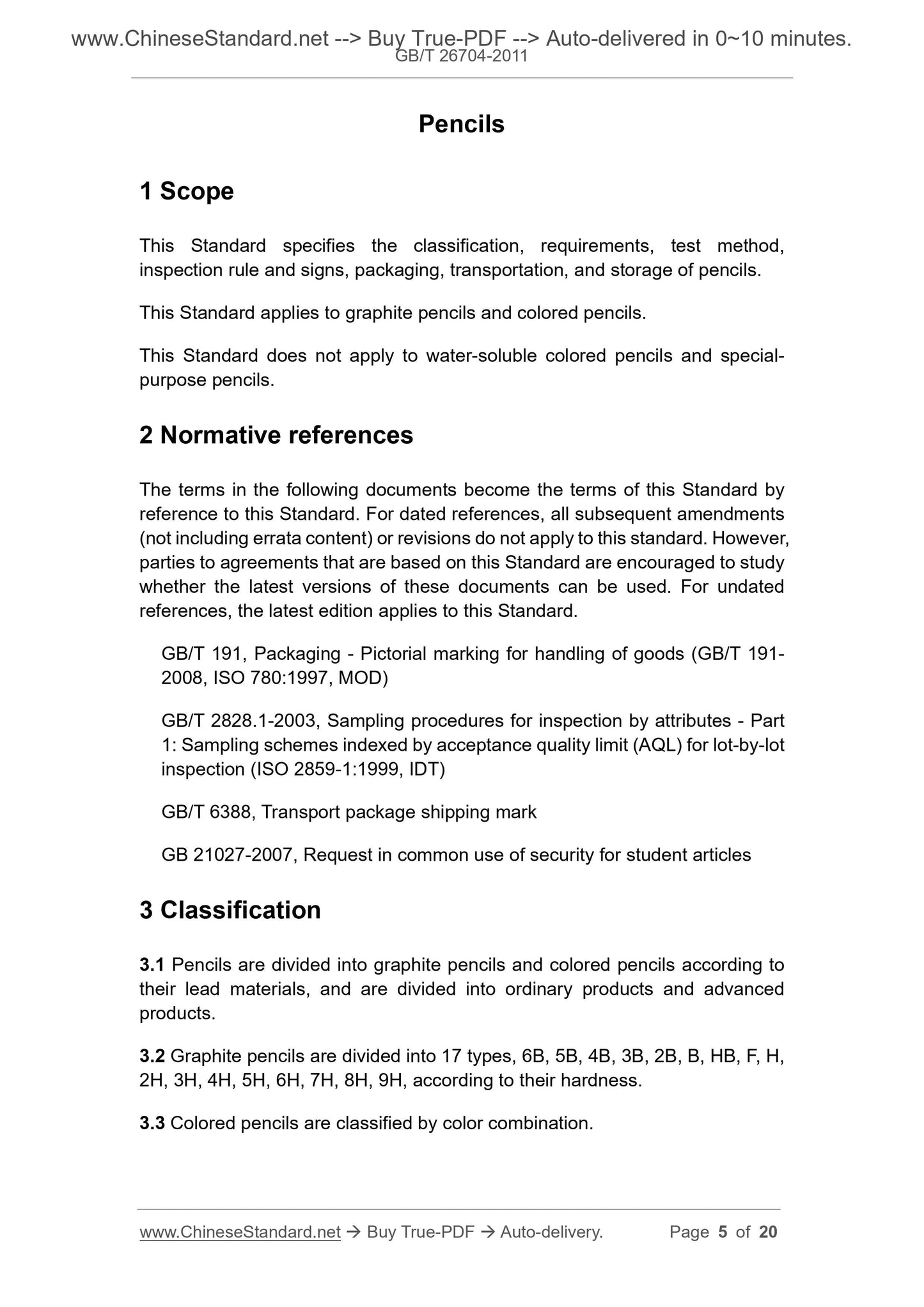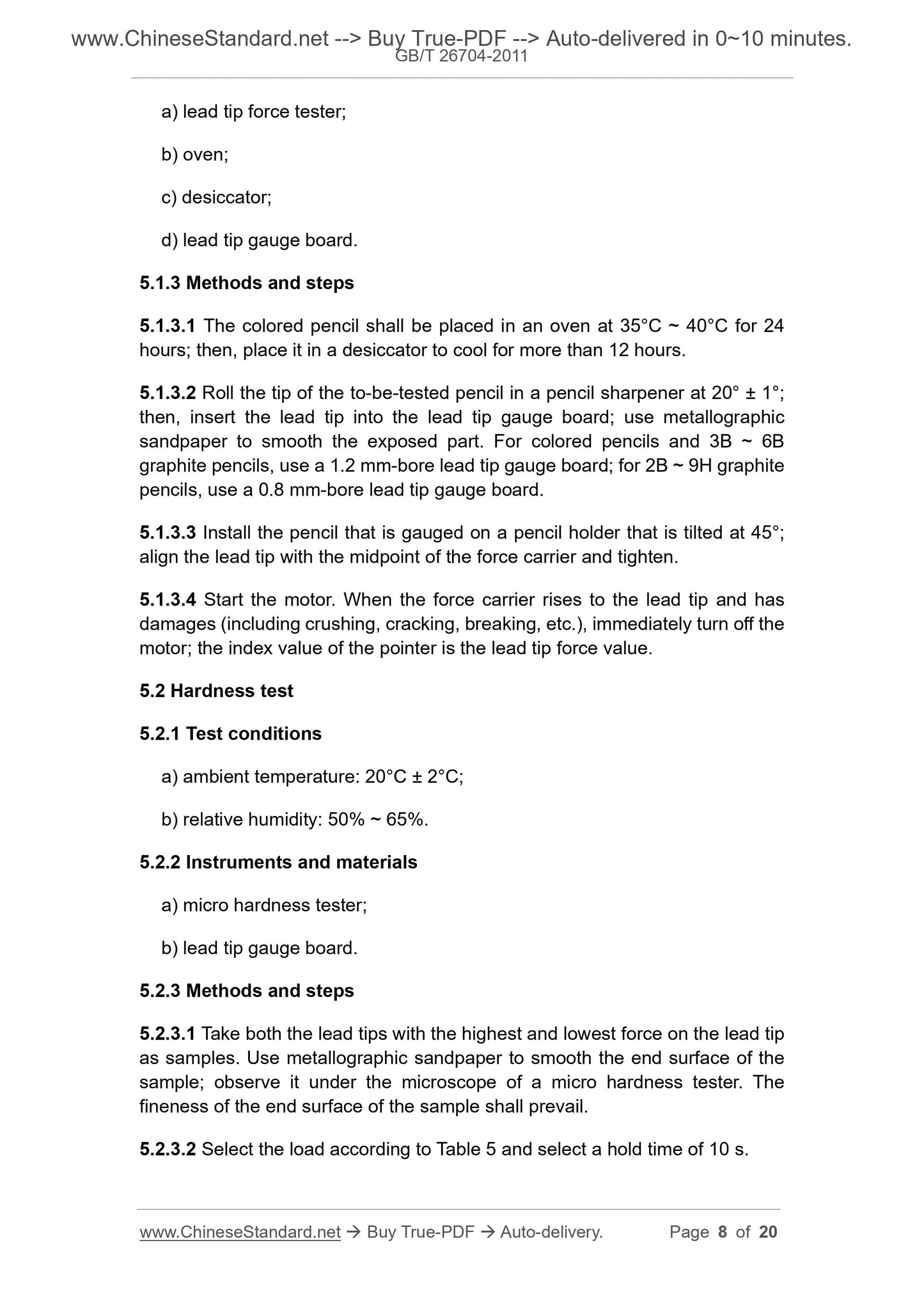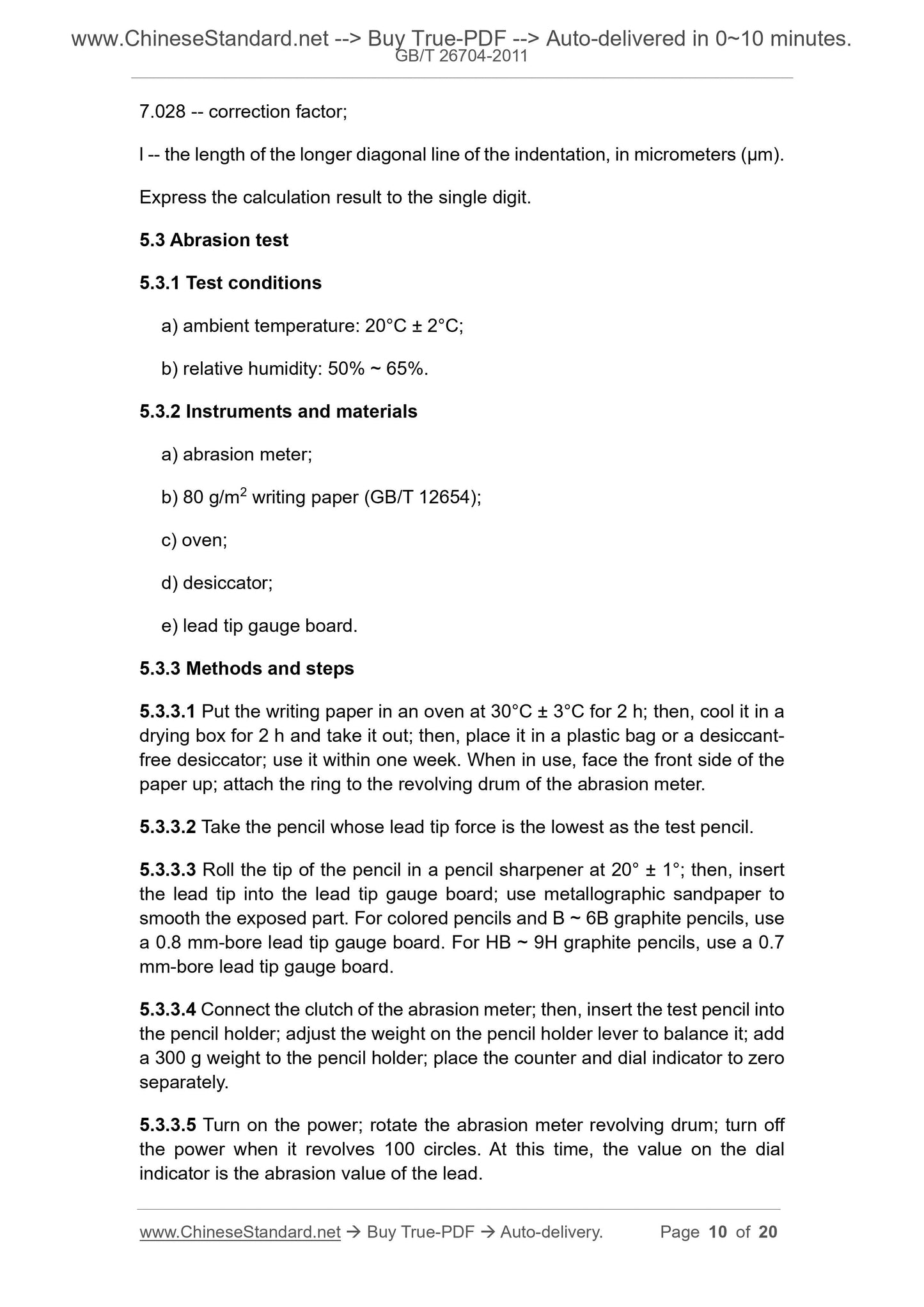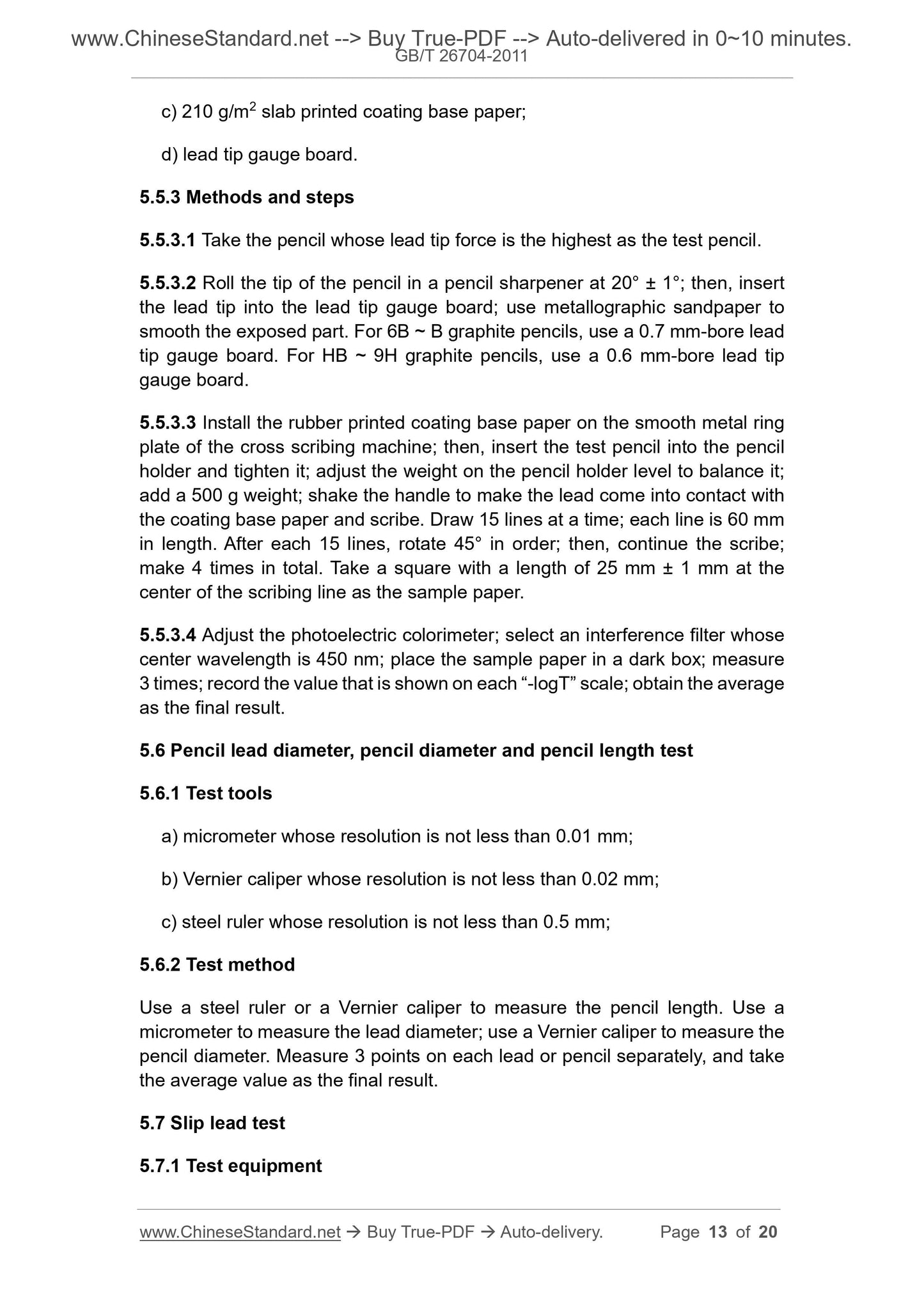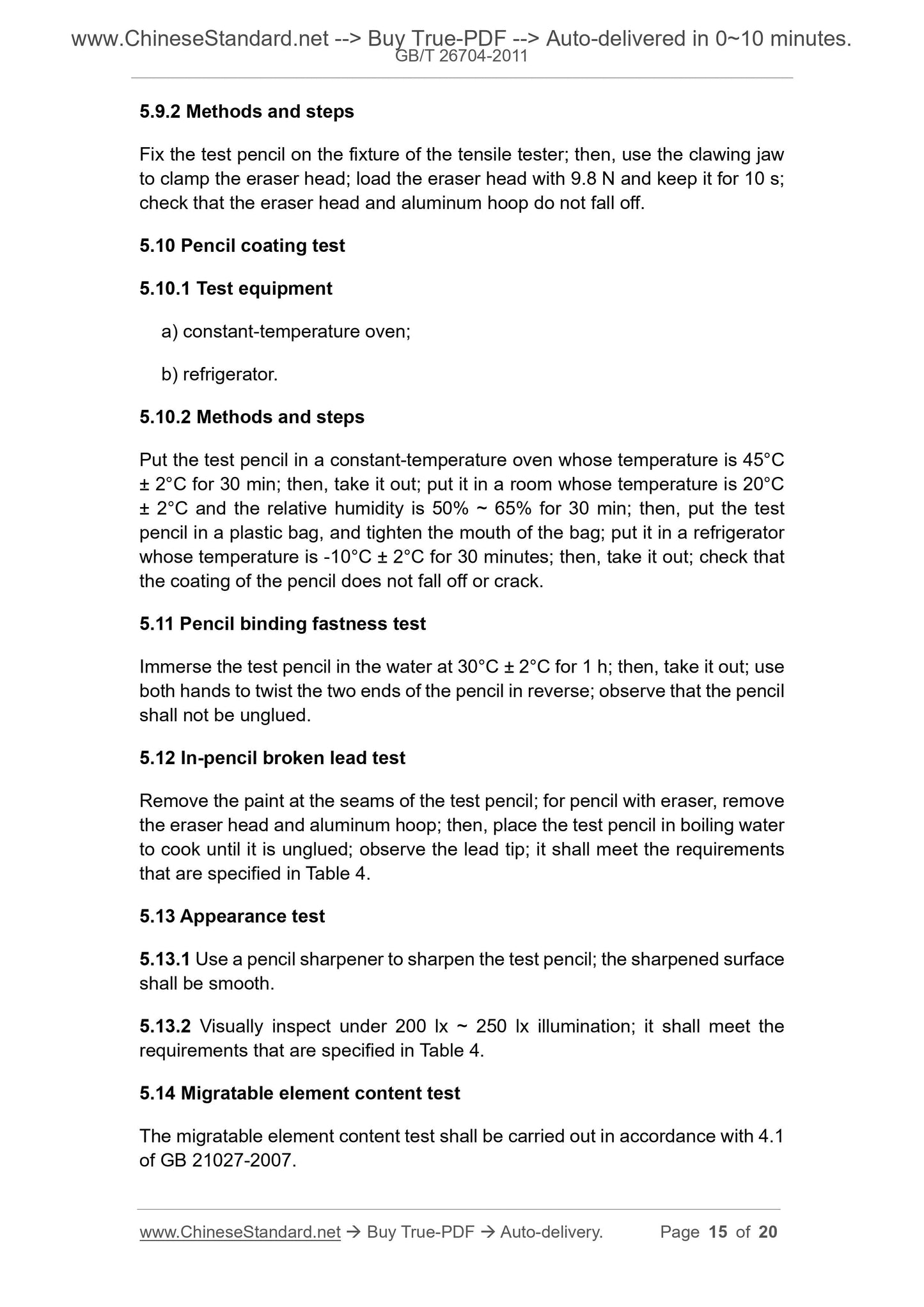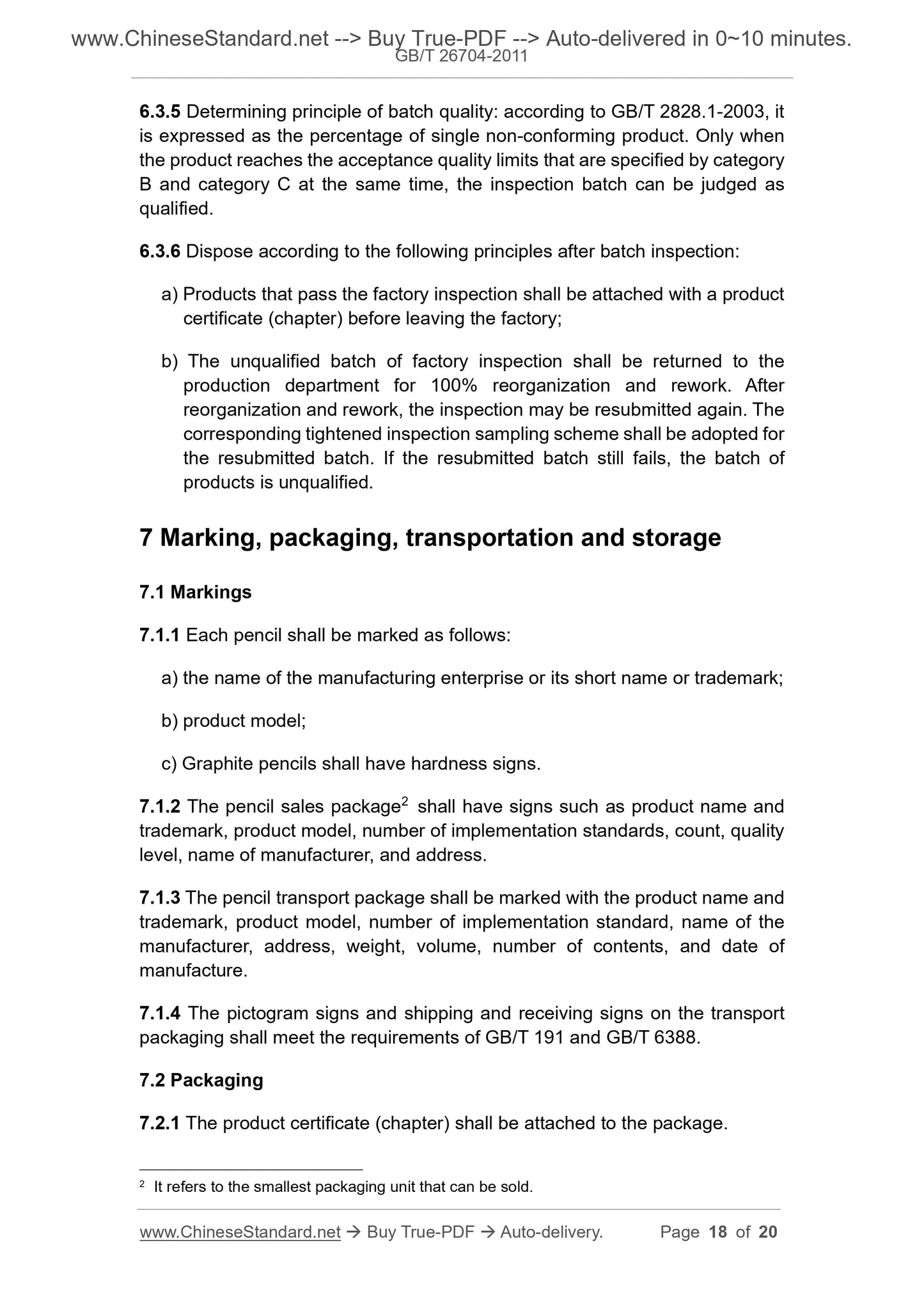1
/
of
8
PayPal, credit cards. Download editable-PDF and invoice in 1 second!
GB/T 26704-2011 English PDF (GBT26704-2011)
GB/T 26704-2011 English PDF (GBT26704-2011)
Regular price
$165.00 USD
Regular price
Sale price
$165.00 USD
Unit price
/
per
Shipping calculated at checkout.
Couldn't load pickup availability
Delivery: 3 seconds. Download true-PDF + Invoice.
Get QUOTATION in 1-minute: Click GB/T 26704-2011
Historical versions: GB/T 26704-2011
Preview True-PDF (Reload/Scroll if blank)
GB/T 26704-2011: Pencils
GB/T 26704-2011
NATIONAL STANDARD OF THE
PEOPLE’S REPUBLIC OF CHINA
ICS 97.180
Y 50
Pencils
铅笔
ISSUED ON: JUNE 16, 2011
IMPLEMENTED ON: DECEMBER 01, 2011
Issued by: General Administration of Quality Supervision, Inspection
and Quarantine;
Standardization Administration of the People’s Republic of
China.
Table of Contents
Foreword ... 3
1 Scope ... 5
2 Normative references ... 5
3 Classification ... 5
4 Requirements ... 6
5 Test method ... 7
6 Inspection rules ... 16
7 Marking, packaging, transportation and storage ... 18
Appendix A (Normative) Recommended pencil diameter ... 20
Pencils
1 Scope
This Standard specifies the classification, requirements, test method,
inspection rule and signs, packaging, transportation, and storage of pencils.
This Standard applies to graphite pencils and colored pencils.
This Standard does not apply to water-soluble colored pencils and special-
purpose pencils.
2 Normative references
The terms in the following documents become the terms of this Standard by
reference to this Standard. For dated references, all subsequent amendments
(not including errata content) or revisions do not apply to this standard. However,
parties to agreements that are based on this Standard are encouraged to study
whether the latest versions of these documents can be used. For undated
references, the latest edition applies to this Standard.
GB/T 191, Packaging - Pictorial marking for handling of goods (GB/T 191-
2008, ISO 780:1997, MOD)
GB/T 2828.1-2003, Sampling procedures for inspection by attributes - Part
1: Sampling schemes indexed by acceptance quality limit (AQL) for lot-by-lot
inspection (ISO 2859-1:1999, IDT)
GB/T 6388, Transport package shipping mark
GB 21027-2007, Request in common use of security for student articles
3 Classification
3.1 Pencils are divided into graphite pencils and colored pencils according to
their lead materials, and are divided into ordinary products and advanced
products.
3.2 Graphite pencils are divided into 17 types, 6B, 5B, 4B, 3B, 2B, B, HB, F, H,
2H, 3H, 4H, 5H, 6H, 7H, 8H, 9H, according to their hardness.
3.3 Colored pencils are classified by color combination.
a) lead tip force tester;
b) oven;
c) desiccator;
d) lead tip gauge board.
5.1.3 Methods and steps
5.1.3.1 The colored pencil shall be placed in an oven at 35°C ~ 40°C for 24
hours; then, place it in a desiccator to cool for more than 12 hours.
5.1.3.2 Roll the tip of the to-be-tested pencil in a pencil sharpener at 20° ± 1°;
then, insert the lead tip into the lead tip gauge board; use metallographic
sandpaper to smooth the exposed part. For colored pencils and 3B ~ 6B
graphite pencils, use a 1.2 mm-bore lead tip gauge board; for 2B ~ 9H graphite
pencils, use a 0.8 mm-bore lead tip gauge board.
5.1.3.3 Install the pencil that is gauged on a pencil holder that is tilted at 45°;
align the lead tip with the midpoint of the force carrier and tighten.
5.1.3.4 Start the motor. When the force carrier rises to the lead tip and has
damages (including crushing, cracking, breaking, etc.), immediately turn off the
motor; the index value of the pointer is the lead tip force value.
5.2 Hardness test
5.2.1 Test conditions
a) ambient temperature: 20°C ± 2°C;
b) relative humidity: 50% ~ 65%.
5.2.2 Instruments and materials
a) micro hardness tester;
b) lead tip gauge board.
5.2.3 Methods and steps
5.2.3.1 Take both the lead tips with the highest and lowest force on the lead tip
as samples. Use metallographic sandpaper to smooth the end surface of the
sample; observe it under the microscope of a micro hardness tester. The
fineness of the end surface of the sample shall prevail.
5.2.3.2 Select the load according to Table 5 and select a hold time of 10 s.
7.028 -- correction factor;
l -- the length of the longer diagonal line of the indentation, in micrometers (μm).
Express the calculation result to the single digit.
5.3 Abrasion test
5.3.1 Test conditions
a) ambient temperature: 20°C ± 2°C;
b) relative humidity: 50% ~ 65%.
5.3.2 Instruments and materials
a) abrasion meter;
b) 80 g/m2 writing paper (GB/T 12654);
c) oven;
d) desiccator;
e) lead tip gauge board.
5.3.3 Methods and steps
5.3.3.1 Put the writing paper in an oven at 30°C ± 3°C for 2 h; then, cool it in a
drying box for 2 h and take it out; then, place it in a plastic bag or a desiccant-
free desiccator; use it within one week. When in use, face the front side of the
paper up; attach the ring to the revolving drum of the abrasion meter.
5.3.3.2 Take the pencil whose lead tip force is the lowest as the test pencil.
5.3.3.3 Roll the tip of the pencil in a pencil sharpener at 20° ± 1°; then, insert
the lead tip into the lead tip gauge board; use metallographic sandpaper to
smooth the exposed part. For colored pencils and B ~ 6B graphite pencils, use
a 0.8 mm-bore lead tip gauge board. For HB ~ 9H graphite pencils, use a 0.7
mm-bore lead tip gauge board.
5.3.3.4 Connect the clutch of the abrasion meter; then, insert the test pencil into
the pencil holder; adjust the weight on the pencil holder lever to balance it; add
a 300 g weight to the pencil holder; place the counter and dial indicator to zero
separately.
5.3.3.5 Turn on the power; rotate the abrasion meter revolving drum; turn off
the power when it revolves 100 circles. At this time, the value on the dial
indicator is the abrasion value of the lead.
c) 210 g/m2 slab printed coating base paper;
d) lead tip gauge board.
5.5.3 Methods and steps
5.5.3.1 Take the pencil whose lead tip force is the highest as the test pencil.
5.5.3.2 Roll the tip of the pencil in a pencil sharpener at 20° ± 1°; then, insert
the lead tip into the lead tip gauge board; use metallographic sandpaper to
smooth the exposed part. For 6B ~ B graphite pencils, use a 0.7 mm-bore lead
tip gauge board. For HB ~ 9H graphite pencils, use a 0.6 mm-bore lead tip
gauge board.
5.5.3.3 Install the rubber printed coating base paper on the smooth metal ring
plate of the cross scribing machine; then, insert the test pencil into the pencil
holder and tighten it; adjust the weight on the pencil holder level to balance it;
add a 500 g weight; shake the handle to make the lead come into contact with
the coating base paper and scribe. Draw 15 lines at a time; each line is 60 mm
in length. After each 15 lines, rotate 45° in order; then, continue the scribe;
make 4 times in total. Take a square with a length of 25 mm ± 1 mm at the
center of the scribing line as the sample paper.
5.5.3.4 Adjust the photoelectric colorimeter; select an interference filter whose
center wavelength is 450 nm; place the sample paper in a dark box; measure
3 times; record the value that is shown on each “-logT” scale; obtain the average
as the final result.
5.6 Pencil lead diameter, pencil diameter and pencil length test
5.6.1 Test tools
a) micrometer whose resolution is not less than 0.01 mm;
b) Vernier caliper whose resolution is not less than 0.02 mm;
c) steel ruler whose resolution is not less than 0.5 mm;
5.6.2 Test method
Use a steel ruler or a Vernier caliper to measure the pencil length. Use a
micrometer to measure the lead diameter; use a Vernier caliper to measure the
pencil diameter. Measure 3 points on each lead or pencil separately, and take
the average value as the final result.
5.7 Slip lead test
5.7...
Get QUOTATION in 1-minute: Click GB/T 26704-2011
Historical versions: GB/T 26704-2011
Preview True-PDF (Reload/Scroll if blank)
GB/T 26704-2011: Pencils
GB/T 26704-2011
NATIONAL STANDARD OF THE
PEOPLE’S REPUBLIC OF CHINA
ICS 97.180
Y 50
Pencils
铅笔
ISSUED ON: JUNE 16, 2011
IMPLEMENTED ON: DECEMBER 01, 2011
Issued by: General Administration of Quality Supervision, Inspection
and Quarantine;
Standardization Administration of the People’s Republic of
China.
Table of Contents
Foreword ... 3
1 Scope ... 5
2 Normative references ... 5
3 Classification ... 5
4 Requirements ... 6
5 Test method ... 7
6 Inspection rules ... 16
7 Marking, packaging, transportation and storage ... 18
Appendix A (Normative) Recommended pencil diameter ... 20
Pencils
1 Scope
This Standard specifies the classification, requirements, test method,
inspection rule and signs, packaging, transportation, and storage of pencils.
This Standard applies to graphite pencils and colored pencils.
This Standard does not apply to water-soluble colored pencils and special-
purpose pencils.
2 Normative references
The terms in the following documents become the terms of this Standard by
reference to this Standard. For dated references, all subsequent amendments
(not including errata content) or revisions do not apply to this standard. However,
parties to agreements that are based on this Standard are encouraged to study
whether the latest versions of these documents can be used. For undated
references, the latest edition applies to this Standard.
GB/T 191, Packaging - Pictorial marking for handling of goods (GB/T 191-
2008, ISO 780:1997, MOD)
GB/T 2828.1-2003, Sampling procedures for inspection by attributes - Part
1: Sampling schemes indexed by acceptance quality limit (AQL) for lot-by-lot
inspection (ISO 2859-1:1999, IDT)
GB/T 6388, Transport package shipping mark
GB 21027-2007, Request in common use of security for student articles
3 Classification
3.1 Pencils are divided into graphite pencils and colored pencils according to
their lead materials, and are divided into ordinary products and advanced
products.
3.2 Graphite pencils are divided into 17 types, 6B, 5B, 4B, 3B, 2B, B, HB, F, H,
2H, 3H, 4H, 5H, 6H, 7H, 8H, 9H, according to their hardness.
3.3 Colored pencils are classified by color combination.
a) lead tip force tester;
b) oven;
c) desiccator;
d) lead tip gauge board.
5.1.3 Methods and steps
5.1.3.1 The colored pencil shall be placed in an oven at 35°C ~ 40°C for 24
hours; then, place it in a desiccator to cool for more than 12 hours.
5.1.3.2 Roll the tip of the to-be-tested pencil in a pencil sharpener at 20° ± 1°;
then, insert the lead tip into the lead tip gauge board; use metallographic
sandpaper to smooth the exposed part. For colored pencils and 3B ~ 6B
graphite pencils, use a 1.2 mm-bore lead tip gauge board; for 2B ~ 9H graphite
pencils, use a 0.8 mm-bore lead tip gauge board.
5.1.3.3 Install the pencil that is gauged on a pencil holder that is tilted at 45°;
align the lead tip with the midpoint of the force carrier and tighten.
5.1.3.4 Start the motor. When the force carrier rises to the lead tip and has
damages (including crushing, cracking, breaking, etc.), immediately turn off the
motor; the index value of the pointer is the lead tip force value.
5.2 Hardness test
5.2.1 Test conditions
a) ambient temperature: 20°C ± 2°C;
b) relative humidity: 50% ~ 65%.
5.2.2 Instruments and materials
a) micro hardness tester;
b) lead tip gauge board.
5.2.3 Methods and steps
5.2.3.1 Take both the lead tips with the highest and lowest force on the lead tip
as samples. Use metallographic sandpaper to smooth the end surface of the
sample; observe it under the microscope of a micro hardness tester. The
fineness of the end surface of the sample shall prevail.
5.2.3.2 Select the load according to Table 5 and select a hold time of 10 s.
7.028 -- correction factor;
l -- the length of the longer diagonal line of the indentation, in micrometers (μm).
Express the calculation result to the single digit.
5.3 Abrasion test
5.3.1 Test conditions
a) ambient temperature: 20°C ± 2°C;
b) relative humidity: 50% ~ 65%.
5.3.2 Instruments and materials
a) abrasion meter;
b) 80 g/m2 writing paper (GB/T 12654);
c) oven;
d) desiccator;
e) lead tip gauge board.
5.3.3 Methods and steps
5.3.3.1 Put the writing paper in an oven at 30°C ± 3°C for 2 h; then, cool it in a
drying box for 2 h and take it out; then, place it in a plastic bag or a desiccant-
free desiccator; use it within one week. When in use, face the front side of the
paper up; attach the ring to the revolving drum of the abrasion meter.
5.3.3.2 Take the pencil whose lead tip force is the lowest as the test pencil.
5.3.3.3 Roll the tip of the pencil in a pencil sharpener at 20° ± 1°; then, insert
the lead tip into the lead tip gauge board; use metallographic sandpaper to
smooth the exposed part. For colored pencils and B ~ 6B graphite pencils, use
a 0.8 mm-bore lead tip gauge board. For HB ~ 9H graphite pencils, use a 0.7
mm-bore lead tip gauge board.
5.3.3.4 Connect the clutch of the abrasion meter; then, insert the test pencil into
the pencil holder; adjust the weight on the pencil holder lever to balance it; add
a 300 g weight to the pencil holder; place the counter and dial indicator to zero
separately.
5.3.3.5 Turn on the power; rotate the abrasion meter revolving drum; turn off
the power when it revolves 100 circles. At this time, the value on the dial
indicator is the abrasion value of the lead.
c) 210 g/m2 slab printed coating base paper;
d) lead tip gauge board.
5.5.3 Methods and steps
5.5.3.1 Take the pencil whose lead tip force is the highest as the test pencil.
5.5.3.2 Roll the tip of the pencil in a pencil sharpener at 20° ± 1°; then, insert
the lead tip into the lead tip gauge board; use metallographic sandpaper to
smooth the exposed part. For 6B ~ B graphite pencils, use a 0.7 mm-bore lead
tip gauge board. For HB ~ 9H graphite pencils, use a 0.6 mm-bore lead tip
gauge board.
5.5.3.3 Install the rubber printed coating base paper on the smooth metal ring
plate of the cross scribing machine; then, insert the test pencil into the pencil
holder and tighten it; adjust the weight on the pencil holder level to balance it;
add a 500 g weight; shake the handle to make the lead come into contact with
the coating base paper and scribe. Draw 15 lines at a time; each line is 60 mm
in length. After each 15 lines, rotate 45° in order; then, continue the scribe;
make 4 times in total. Take a square with a length of 25 mm ± 1 mm at the
center of the scribing line as the sample paper.
5.5.3.4 Adjust the photoelectric colorimeter; select an interference filter whose
center wavelength is 450 nm; place the sample paper in a dark box; measure
3 times; record the value that is shown on each “-logT” scale; obtain the average
as the final result.
5.6 Pencil lead diameter, pencil diameter and pencil length test
5.6.1 Test tools
a) micrometer whose resolution is not less than 0.01 mm;
b) Vernier caliper whose resolution is not less than 0.02 mm;
c) steel ruler whose resolution is not less than 0.5 mm;
5.6.2 Test method
Use a steel ruler or a Vernier caliper to measure the pencil length. Use a
micrometer to measure the lead diameter; use a Vernier caliper to measure the
pencil diameter. Measure 3 points on each lead or pencil separately, and take
the average value as the final result.
5.7 Slip lead test
5.7...
Share
